Application of Thermally Responsive Elastin-like Polypeptide Fused to a Lactoferrin-derived Peptide for Treatment of Pancreatic Cancer
Abstract
:1. Introduction
2. Results and Discussion
2.1. Design and thermal properties of Tat-ELP-L12
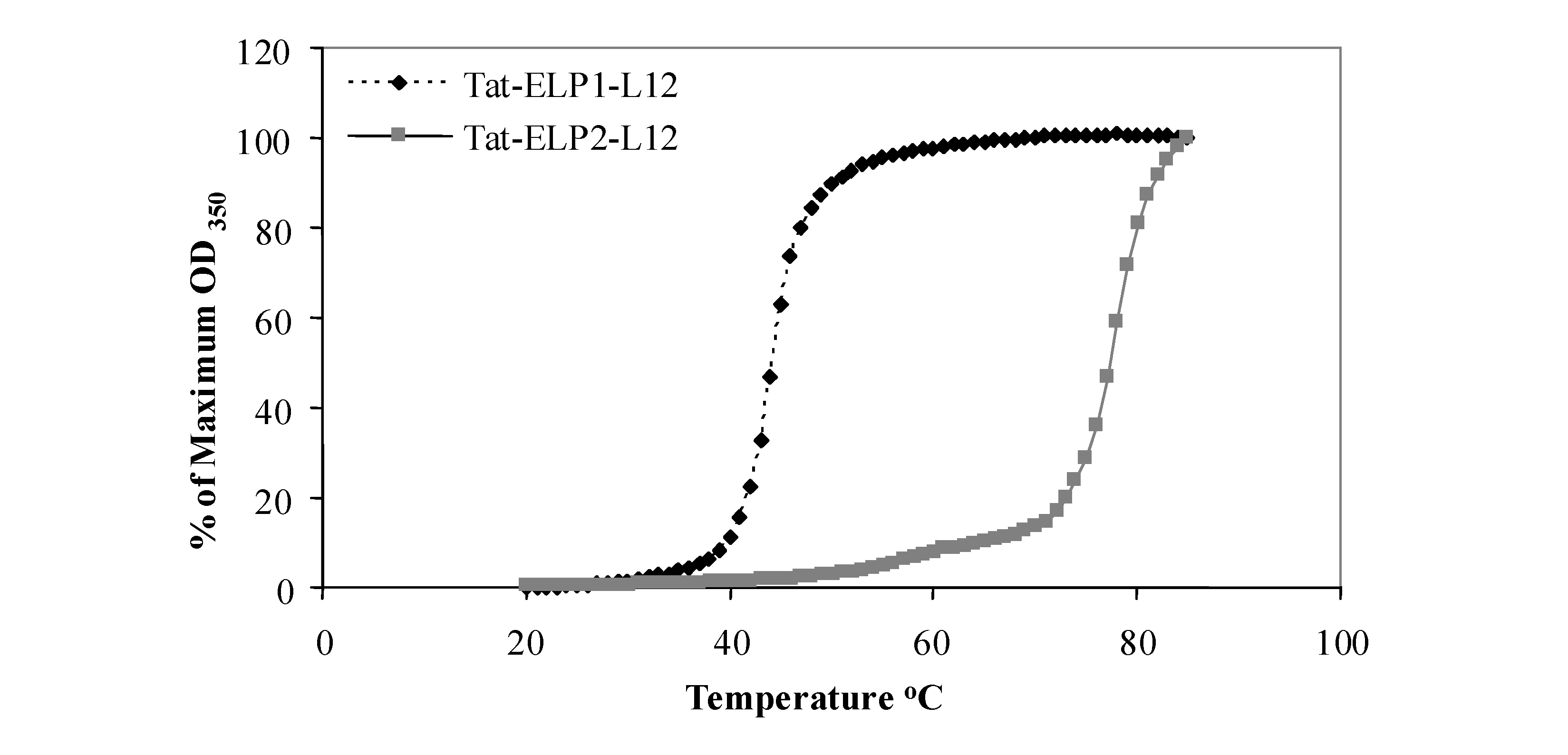
2.2. Effect of polypeptides on cell proliferation
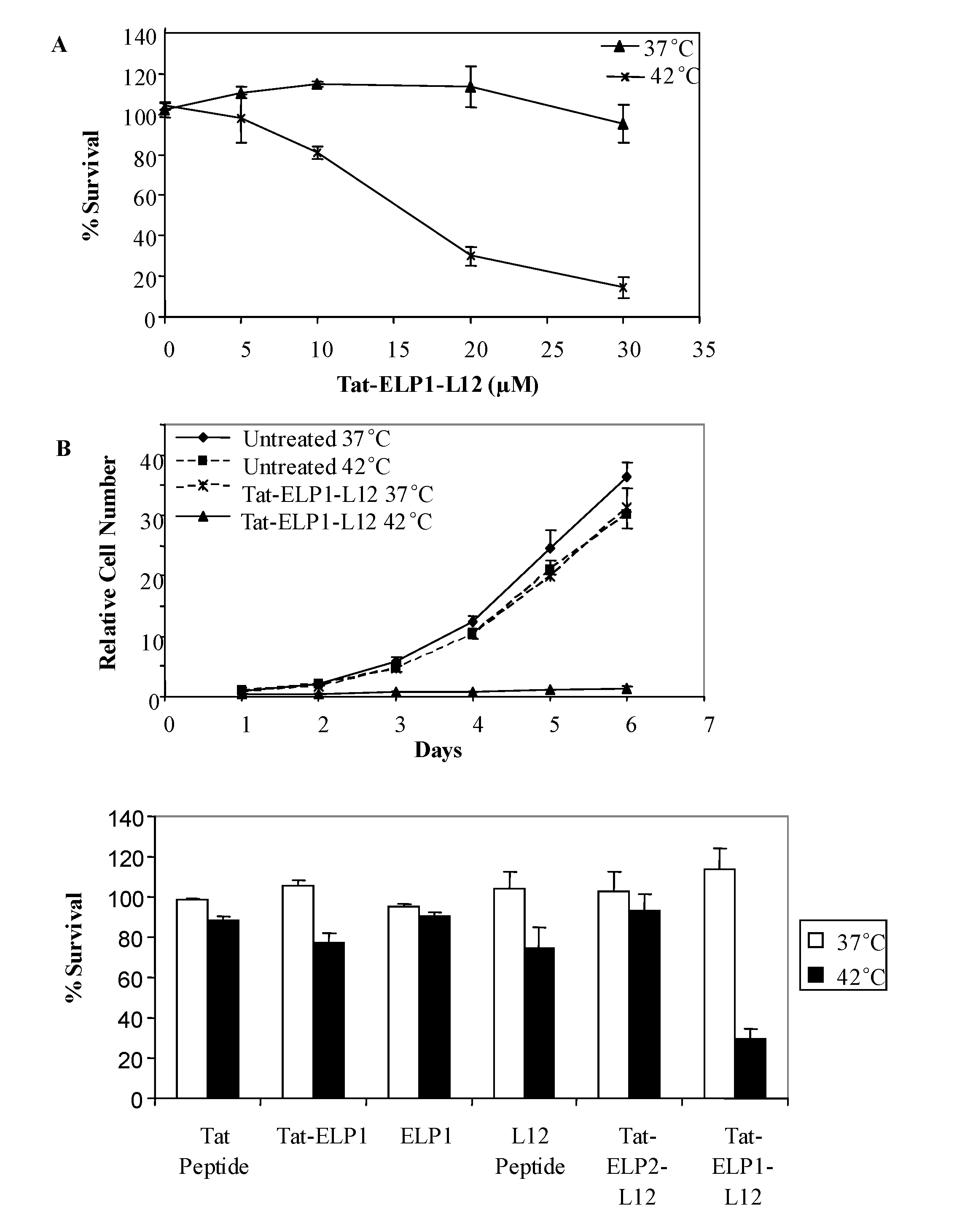
| Polypeptide Name | Polypeptide Sequence | Molecular Weight (kDa) |
|---|---|---|
| ELP1 | SKGPG-(VPGXG)150†-WP | 59.2 |
| ELP2 | SKGPG-(VPGXG)160‡-WP | 60.1 |
| Tat-ELP1 | YGRKKRRQRRRGGPG-(VPGXG)150†-WPGSGGC | 61.3 |
| Tat-ELP2 | YGRKKRRQRRRGGPG-(VPGXG)160‡-WPGSGGC | 62.8 |
| Tat-ELP1-L12 | YGRKKRRQRRRGGPG-(VPGXG)150† | 63.5 |
| WPGSGGPAWRKAFRWAKRMLKKAA | ||
| Tat-ELP2-L12 | YGRKKRRQRRRGGPG-(VPGXG)160‡-WPGSG | 64.9 |
| GPAWRKAFRWAKRMLKKAA | ||
| Tat | YGRKKRRQRRR | 1.6 |
| L12 | GPAWRKAFRWAKRMLKKAA | 2.3 |
2.3. Measurement of Lactate Dehydrogenase (LDH) release
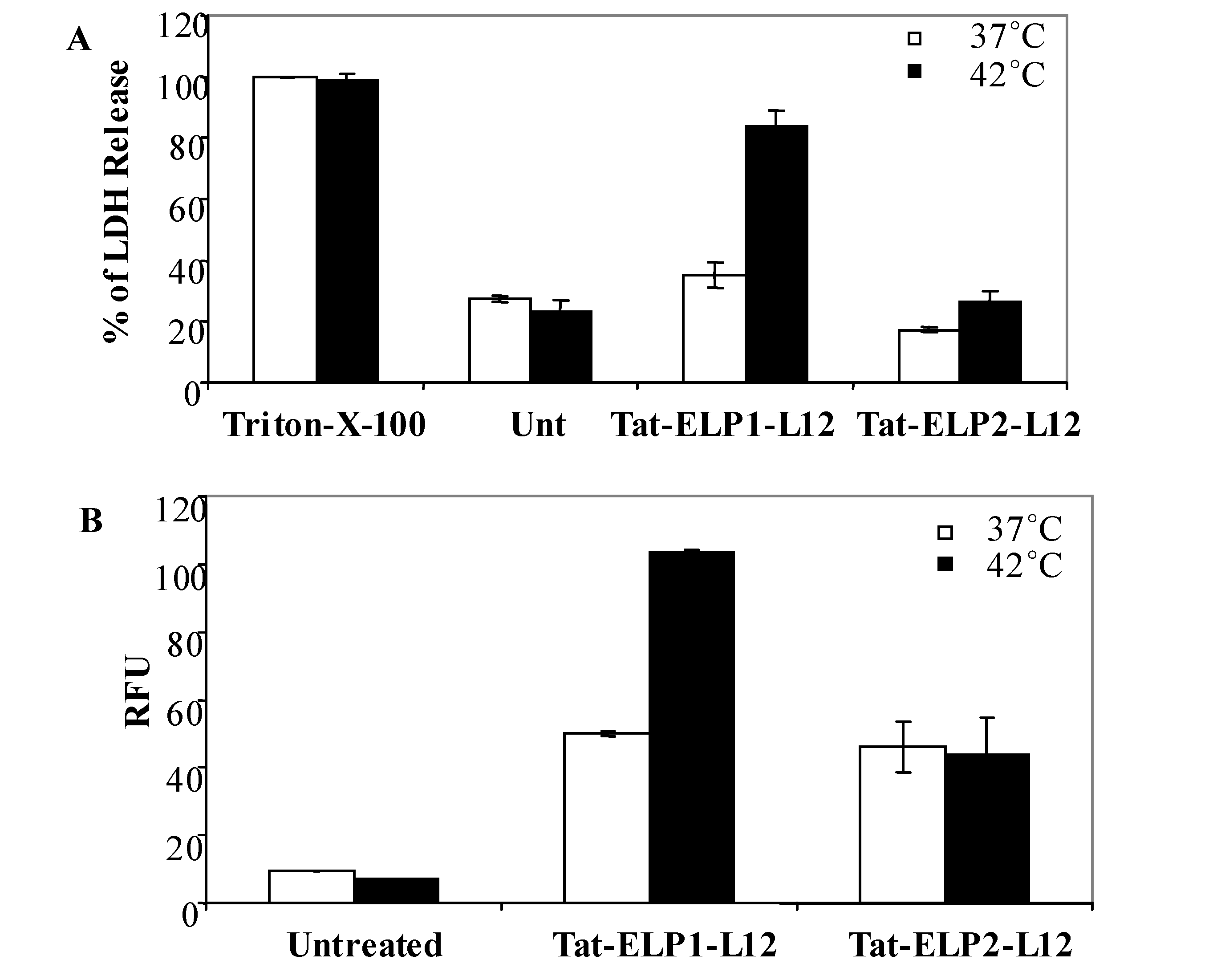
2.4. Measurement of FITC-Dextran uptake
2.5. Tat-ELP1-L12 also induces apoptotic cell death
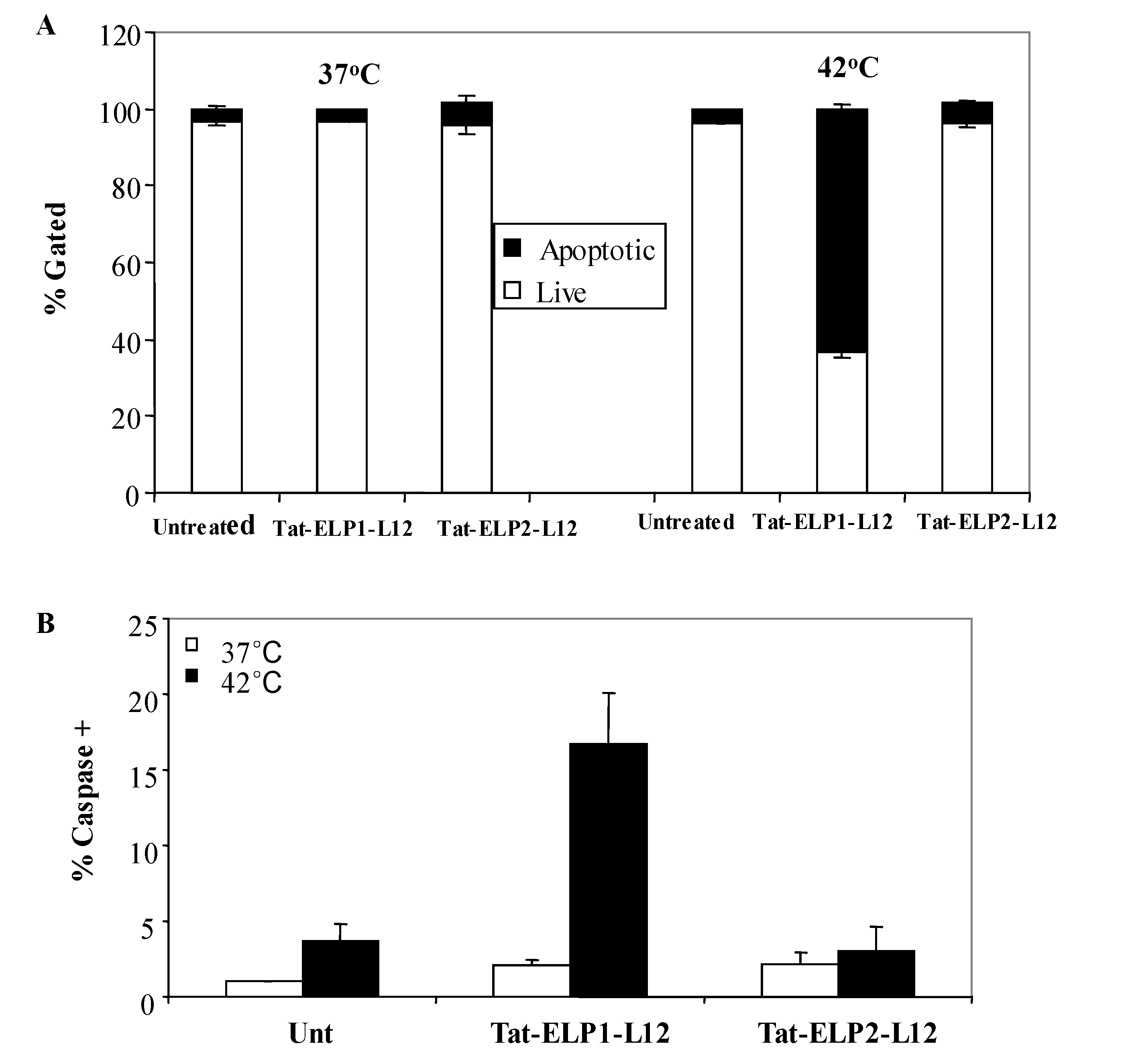
2. 5. Cell proliferation in other cell lines
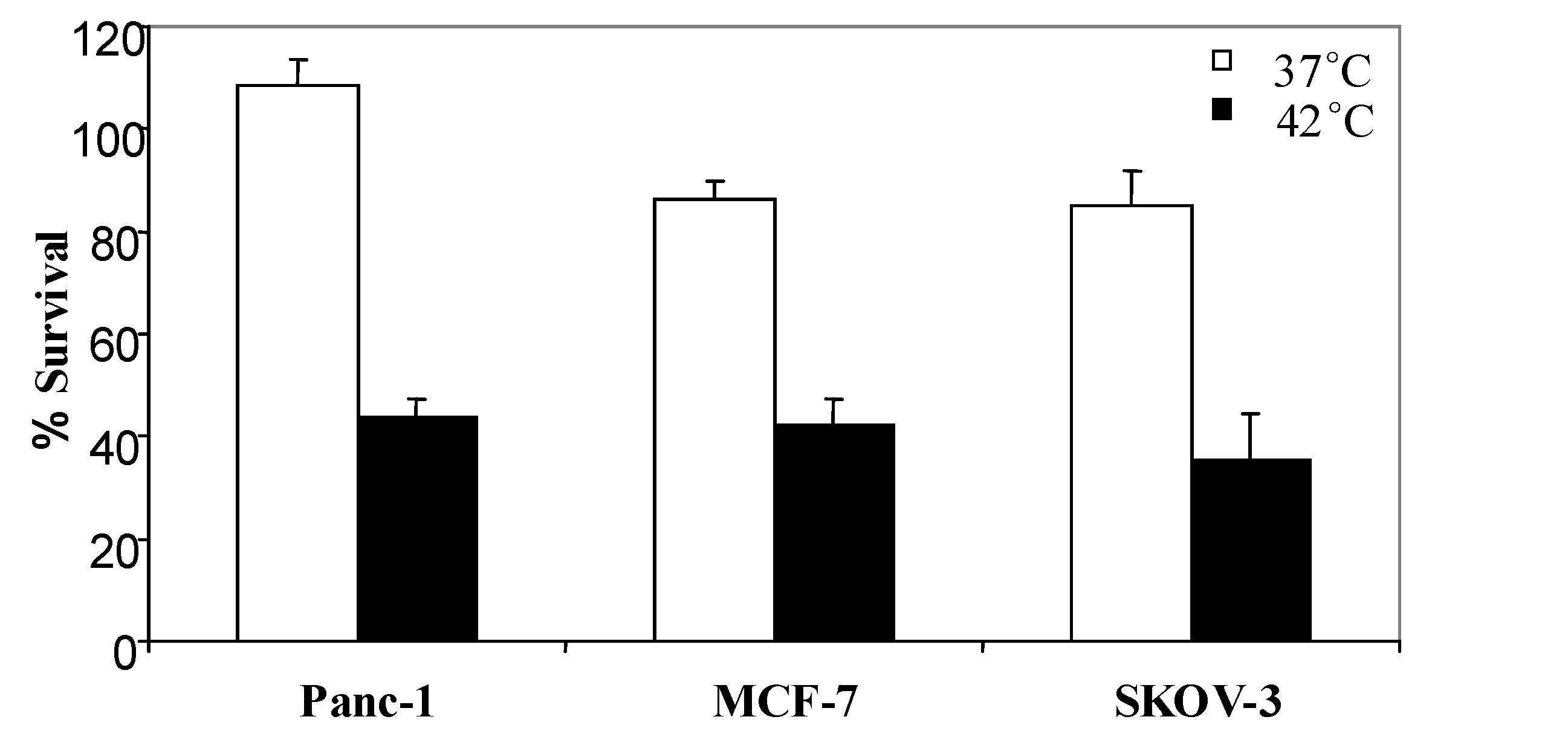
2.6. Measurement of Hemolytic activity
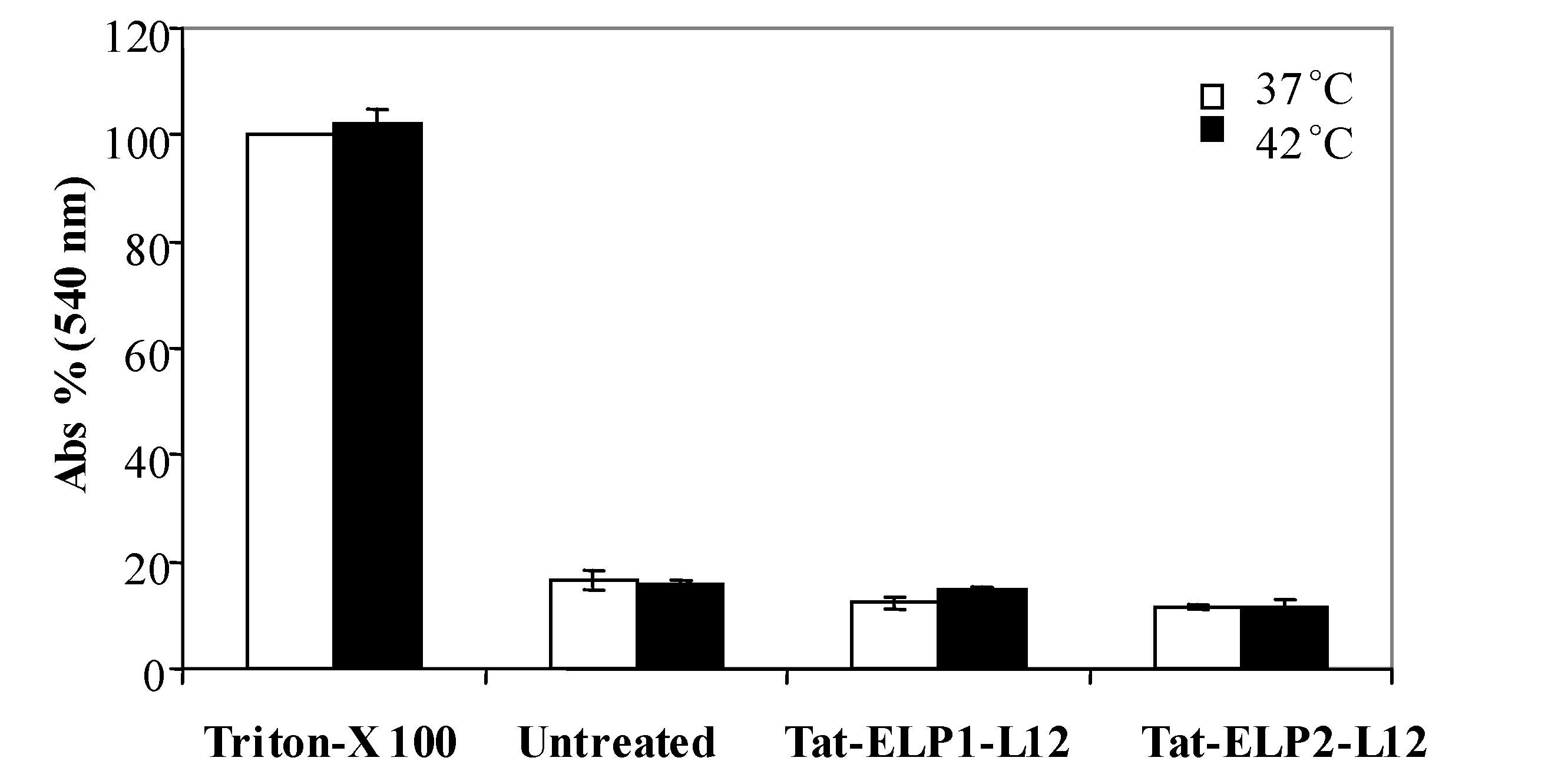
3. Experimental
3.1. Design of Constructs
3.2. Polypeptide purification
3.3. Characterization of transition temperature
3.4. Cell culture and polypeptide treatment
3.5. Cell proliferation
3.6. Lactate dehydrogenase relase (LDH) assay
3.7. FITC-Dextran uptake assay
3.8. Caspase detection assay
3.9. Mitochondrial membrane depolarization assay
3.10. Hemolytic activity
4. Conclusions
Acknowledgements
References and Notes
- Allen, T.M. Liposomal drug formulation: rationale for development and what we can expect in the future. Drugs 1998, 56, 747–756. [Google Scholar] [CrossRef]
- El-Aneed, A. An overview of current delivery systems in cancer gene therapy. J. Control. Release 2004, 94, 1–14. [Google Scholar] [CrossRef]
- Torchilin, V.P. Polymer-coated long-circulating microparticulate pharmaceuticals. J. Microencapsul. 1998, 15, 1–19. [Google Scholar] [CrossRef]
- Langer, R. Drug delivery and targeting. Nature (Lond.) 1998, 392 (Suppl.), 5–10. [Google Scholar]
- Duncan, R.; Vicent, M.J.; Greco, F.; Nicholson, R.I. Polymer-drug conjugates: towards a novel approach for the treatment of endrocine-related cancer. Endocr. Relat. Cancer 2005, 12 Suppl.1, S189–S99. [Google Scholar]
- Kopecek, J.; Kopeckova, P.; Minko, T.; Lu, Z. HPMA copolymer-anticancer drug conjugates: design, activity, and mechanism of action. Eur. J. Pharm. Biopharm. 2000, 50, 61–81. [Google Scholar] [CrossRef]
- Takakura, Y.; Fujita, T.; Hashida, M.; Sezaki, H. Disposition characteristics of macromolecules in tumor-bearing mice. Pharm. Res. 1990, 7, 339–346. [Google Scholar] [CrossRef]
- Maeda, H.; Seymour, L.W.; Miyamoto, Y. Conjugates of anticancer agents and polymers: advantages of macromolecular therapeutics in vivo. Bioconjug. Chem. 1992, 3, 351–362. [Google Scholar]
- Cassidy, J.; Duncan, R.; Morrison, G.J.; Strohalm, J.; Plocova, D.; Kopecek, J.; Kaye, S.B. Activity of N-(2-hydroxypropyl)methacrylamide copolymers containing daunomycin against a rat tumour model. Biochem. Pharmacol. 1989, 38, 875–879. [Google Scholar] [CrossRef]
- Yamaoka, T.; Tabata, Y.; Ikada, Y. Distribution and tissue uptake of poly(ethylene glycol) with different molecular weights after intravenous administration to mice. J. Pharm. Sci 1994, 83, 601–606. [Google Scholar] [CrossRef]
- Bidwell, G.L.; Fokt, I.; Priebe, W.; Raucher, D. Development of elastin-like polypeptide for thermally targeted delivery of doxorubicin. Biochem. Pharmacol. 2007, 73, 620–631. [Google Scholar] [CrossRef]
- Meyer, D.E.; Kong, G.A.; Dewhirst, M.W.; Zalutsky, M.R.; Chilkoti, A. Targeting a Genetically Engineered Elastin-like Polypeptide to Solid Tumors by Local Hyperthermia. Cancer Res. 2001, 61, 1548–1554. [Google Scholar]
- Yang, N.; Stensen, W.; Svendsen, J.S.; Rekdal, O. Enhanced antitumor activity and selectivity of lactoferrin-derived peptides. J. Pept. Res. 2002, 60, 187–197. [Google Scholar] [CrossRef]
- Yang, N.; Strom, M.B.; Mekonnen, S.M.; Svendsen, J.S.; Rekdal, O. The effects of shortening lactoferrin derived peptides against tumour cells, bacteria and normal human cells. J. Pept. Sci. 2004, 10, 37–46. [Google Scholar] [CrossRef]
- Mader, J.S.; Richardson, A.; Salsman, J.; Top, D.; de Antueno, R.; Duncan, R.; Hoskin, D.W. Bovine lactoferricin causes apoptosis in Jurkat T-leukemia cells by sequential permeabilization of the cell membrane and targeting of mitochondria. Exp. Cell Res. 2007, 313, 2634–2650. [Google Scholar]
- Mader, J.S.; Salsman, J.; Conrad, D.M.; Hoskin, D.W. Bovine lactoferricin selectively induces apoptosis in human leukemia and carcinoma cell lines. Mol. Cancer Ther. 2005, 4, 612–624. [Google Scholar]
- Eliassen, L.T.; Berge, G.; Leknessund, A.; Wikman, M.; Lindin, I.; Lokke, C.; Ponthan, F.; Johnsen, J.I.; Sveinbjornsson, B.; Kogner, P.; Flaegstad, T.; Rekdal, O. The antimicrobial peptide, lactoferricin B, is cytotoxic to neuroblastoma cells in vitro and inhibits xenograft growth in vivo. Int. J. Cancer 2006, 119, 493–500. [Google Scholar]
- Yoo, Y.C.; Watanabe, R.; Koike, Y.; Mitobe, M.; Shimazaki, K.; Watanabe, S.; Azuma, I. Apoptosis in human leukemic cells induced by lactoferricin, a bovine milk protein-derived peptide: involvement of reactive oxygen species. Biochem. Biophys. Res. Commun. 1997, 237, 624–628. [Google Scholar] [CrossRef]
- Yoo, Y. C.; Watanabe, S.; Watanabe, R.; Hata, K.; Shimazaki, K.; Azuma, I. Bovine lactoferrin and Lactoferricin inhibit tumor metastasis in mice. Adv. Exp. Med. Biol. 1998, 443, 285–291. [Google Scholar]
- Onishi, J.; Roy, M.K.; Juneja, LR.; Watanabe, Y.; Tamai, Y. A lactoferrin-derived peptide with cationic residues concentrated in a region of its helical structure induces necrotic cell death in a leukemic cell line (HL-60). J. Pept. Sci. 2008, 14, 1032–1038. [Google Scholar] [CrossRef]
- Snyder, E.L.; Dowdy, S.F. Cell penetrating peptides in drug delivery. Pharm. Res. 2004, 21, 389–393. [Google Scholar] [CrossRef]
- Liu, W.; Dreher, M.R.; Furgeson, D.Y.; Peixoto, K.V.; Yuan, H.; Zalutsky, M.R.; Chilkoti, A. Tumor accumulation, degradation and pharmacokinetics of elastin-like polypeptides in nude mice. J. Control. Release 2006, 116, 170–178. [Google Scholar] [CrossRef]
- Tatham, A.S.; Shewry, P.R. Elastomeric proteins: biological roles, structures and mechanisms. Trends Biochem. Sci. 2000, 25, 567–571. [Google Scholar] [CrossRef]
- Urry, D.W.; Luan, C.-H.; Parker, T.M.; Gowda, D.C.; Prasad, K.U.; Reid, M.C.; Safavy, A. Temperature of Polypeptide Inverse Temperature Transition Depends on Mean Residue Hydrophobicity. J. Am. Chem. Soc. 1991, 113, 4346–4348. [Google Scholar]
- Fujiwara, K.; Watanabe, T. Effects of hyperthermia, radiotherapy and thermoradiotherapy on tumor microvascular permeability. Acta Pathol. Jpn. 1990, 40, 79–84. [Google Scholar]
- Gerlowski, L.E.; Jain, R.K. Effect of hyperthermia on microvascular permeability to macromolecules in normal and tumor tissues. Int. J. Microcirc. Clin. Exp. 1985, 4, 363–372. [Google Scholar]
- Jain, R.K. Transport of molecules across tumor vasculature. Cancer Metastasis Rev. 1987, 6, 559–593. [Google Scholar] [CrossRef]
- Temsamani, J.; Guinot, P. Antisense oligonucleotides: a new therapeutic approach. Biotechnol. Appl. Biochem. 1997, 26, 65–71. [Google Scholar]
- Temsamani, J.; Vidal, P. The use of cell-penetrating peptides for drug delivery. Drug Discov. Today 2004, 9, 1012–1019. [Google Scholar]
- Nori, A.; Kopecek, J. Intracellular targeting of polymer-bound drugs for cancer chemotherapy. Adv Drug Deliv. Rev. 2005, 57, 609–636. [Google Scholar] [CrossRef]
- Massodi, I.; Bidwell, G.L.; Raucher, D. Evaluation of cell penetrating peptides fused to elastin-like polypeptide for drug delivery. J. Control. Release 2005, 108, 396–408. [Google Scholar] [CrossRef]
- Massodi, I.; Raucher, D. A thermally responsive Tat-elastin-like polypeptide fusion protein induces membrane leakage, apoptosis, and cell death in human breast cancer cells. J. Drug Target 2007, 15, 611–622. [Google Scholar] [CrossRef]
- Vives, E.; Brodin, P.; Lebleu, B. A truncated HIV-1 Tat protein basic domain rapidly translocates through the plasma membrane and accumulates in the cell nucleus. J. Biol. Chem. 1997, 272, 16010–16017. [Google Scholar] [CrossRef]
- Meyer, D.E.; Shin, B.C.; Kong, G.A.; Dewhirst, M.W.; Chilkoti, A. Drug targeting using thermally responsive polymers and local hyperthermia. J. Control. Release 2001, 74, 213–224. [Google Scholar] [CrossRef]
- Bidwell, G.L.; Raucher, D. Application of thermally responsive polypeptides directed against c-Myc transcriptional function for cancer therapy. Mol. Cancer Ther. 2005, 4, 1076–1085. [Google Scholar] [CrossRef]
- Chilkoti, A.; Dreher, M.R.; Meyer, D.E. Design of thermally responsive, recombinant polypeptide carriers for targeted drug delivery. Adv. Drug Deliv. Rev. 2002, 54, 1093–1111. [Google Scholar] [CrossRef]
- Bidwell, G.L. Enhancing the Antiproliferative Effect of Topoisomerase II Inhibitors Using a Polypeptide Inhibitor of c-Myc. Biochem. Pharm. 2005, in press. [Google Scholar]
- Bidwell, G.L.; Fokt, I.; Priebe, W.; Raucher, D. Development of Elastin-like Polypeptide for Thermally-targeted Delivery of Doxorubicin. Biochem. Pharmacol. 2006. In Press. [Google Scholar]
- Hristova, K.; Dempsey, C. E.; White, S. H. Structure, location, and lipid perturbations of melittin at the membrane interface. Biophys. J. 2001, 80, 801–811. [Google Scholar] [CrossRef]
- Lehmann, J.; Retz, M.; Sidhu, S.S.; Suttmann, H.; Sell, M.; Paulsen, F.; Harder, J.; Unteregger, G.; Stockle, M. Antitumor activity of the antimicrobial peptide magainin II against bladder cancer cell lines. Eur. Urol. 2006, 50, 141–147. [Google Scholar] [CrossRef]
- Mori, S.; Watanabe, W.; Shigeta, S. A colorimetric LDH assay for the titration of infectivity and the evaluation of anti-viral activity against ortho- and paramyxoviruses. Tohoku J. Exp. Med. 1995, 177, 315–325. [Google Scholar] [CrossRef]
- Jurisic, V.; Spuzic, I.; Konjevic, G. A comparison of the NK cell cytotoxicity with effects of TNF-alpha against K-562 cells, determined by LDH release assay. Cancer Lett. 1999, 138, 67–72. [Google Scholar] [CrossRef]
- Do, T.N.; Rosal, R.V.; Drew, L.; Raffo, A.J.; Michl, J.; Pincus, M.R.; Friedman, F.K.; Petrylak, D.P.; Cassai, N.; Szmulewicz, J.; Sidhu, G.; Fine, R.L. Brandt-Rauf, P.W. Preferential induction of necrosis in human breast cancer cells by a p53 peptide derived from the MDM2 binding site. 2000, 22, 1431–1444. [Google Scholar]
- Kroemer, G.; Dallaporta, B.; Resche-Rigon, M. The mitochondrial death/life regulator in apoptosis and necrosis. Annu. Rev. Physiol. 1998, 60, 619–642. [Google Scholar] [CrossRef]
- Zou, H.; Henzel, W.J.; Liu, X.; Lutschg, A.; Wang, X. Apaf-1, a human protein homologous to C. elegans CED-4, participates in cytochrome c-dependent activation of caspase-3. Cell 1997, 90, 405–413. [Google Scholar]
- Meyer, D.E.; Chilkoti, A. Purification of Recombinant Proteins by Fusion with Thermally Responsive Polypeptides. Nat. Biotechnol. 1999, 17, 1112–1115. [Google Scholar] [CrossRef]
- Sample Availability: Not available.
© 2009 by the authors; licensee Molecular Diversity Preservation International, Basel, Switzerland. This article is an open-access article distributed under the terms and conditions of the Creative Commons Attribution license ( http://creativecommons.org/licenses/by/3.0/).
Share and Cite
Massodi, I.; Thomas, E.; Raucher, D. Application of Thermally Responsive Elastin-like Polypeptide Fused to a Lactoferrin-derived Peptide for Treatment of Pancreatic Cancer. Molecules 2009, 14, 1999-2015. https://doi.org/10.3390/molecules14061999
Massodi I, Thomas E, Raucher D. Application of Thermally Responsive Elastin-like Polypeptide Fused to a Lactoferrin-derived Peptide for Treatment of Pancreatic Cancer. Molecules. 2009; 14(6):1999-2015. https://doi.org/10.3390/molecules14061999
Chicago/Turabian StyleMassodi, Iqbal, Emily Thomas, and Drazen Raucher. 2009. "Application of Thermally Responsive Elastin-like Polypeptide Fused to a Lactoferrin-derived Peptide for Treatment of Pancreatic Cancer" Molecules 14, no. 6: 1999-2015. https://doi.org/10.3390/molecules14061999
APA StyleMassodi, I., Thomas, E., & Raucher, D. (2009). Application of Thermally Responsive Elastin-like Polypeptide Fused to a Lactoferrin-derived Peptide for Treatment of Pancreatic Cancer. Molecules, 14(6), 1999-2015. https://doi.org/10.3390/molecules14061999




